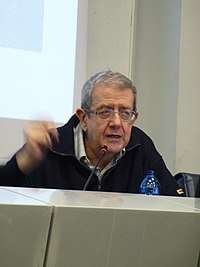Lucio Russo
| Lucio Russo | |
|---|---|
 Lucio Russo in 2014 | |
| Born |
November 22, 1944 Venice |
| Nationality | Italian |
| Scientific career | |
| Fields | Physics, Mathematics, History of Science |
| Institutions | University of Rome Tor Vergata |
Lucio Russo (born 22 November 1944) is an Italian physicist, mathematician and historian of science. Born in Venice, he teaches at the Mathematics Department of the University of Rome Tor Vergata.
Among his main areas of interest are Gibbs measure of the Ising model, percolation theory,[1] and finite Bernoulli schemes, within which he proved an approximate version of the classical Kolmogorov's zero–one law.[2]
In the history of science, he has reconstructed some contributions of the Hellenistic astronomer Hipparchus, through the analysis of his surviving works, and the proof of heliocentrism attributed by Plutarch to Seleucus of Seleucia and studied the history of theories of tides[3], from the Hellenistic to modern age.
Works
In The Forgotten Revolution: How Science Was Born in 300 BC and Why It Had to Be Reborn (Italian: La rivoluzione dimenticata), Russo promotes the belief that Hellenistic science in the period 320–144 BC reached heights not achieved by Classical age science, and proposes that it went further than ordinarily thought, in multiple fields not normally associated with ancient science.
Hellenistic science was focused on the city of Alexandria. The emerging scientific revolution in Alexandria was ended when Ptolemy VIII Physcon came to power. He engaged in mass purges and expulsions of all intellectuals. Other centers of Hellenistic science mentioned in Russo's book were Antioch, Pergamon, Cyzicus, Rhodes, Syracuse and Massilia.
He also concludes that the 17th-century scientific revolution in Europe was due in large part to the recovery of Hellenistic science.[4] The Forgotten Revolution has received mixed reviews, praising Russo's enthusiasm but noting that his conclusions outreach his sources.[5][6][7][8]
In L' America dimenticata, Russo suggests that the Americas were known to some European civilizations in ancient times, probably discovered by the Phoenicians or the Carthaginians, but that the knowledge was lost under Roman expansion in the 2nd century BCE.[9]
See also
- Antikythera mechanism, a Hellenistic astronomical computer, which, according to Russo, is a proof of the high level of knowledge in science and technology reached during Hellenism
References
- ↑ Geoffrey R. Grimmett, "The Work of Lucio Russo on Percolation","Mathematics and Mechanics of Complex Systems", vol. 4, N° 3–4, pp. 199–211 http://msp.org/memocs/2016/4-3/p02.xhtml
- ↑ M. Talegrand "On Russo's approximate zero-one law", “Annals of Probability”, 22, (1994), 1576–1587
- ↑ Lucio Russo, Flussi e riflussi: indagine sull'origine di una teoria scientifica, Milan, Feltrinelli, 2003, ISBN 88-07-10349-4.
- ↑ Lucio Russo, The Forgotten Revolution: How Science Was Born in 300 BC and Why It Had to Be Reborn, Berlin, Springer, 2004, ISBN 978-3-540-20396-4.
- ↑ Michael Rowan-Robinson, "Praising Alexandrians to excess." Review of The Forgotten Revolution, Physics World vol. 17, no. 4 (April 2004).
- ↑ Gary B. Magee, Review of The Forgotten Revolution, Economic Record, 80 (2004): 475–476.
- ↑ Samuel S. Kutler, Read This! The Mathematical Association of America Online book review column (20 September 2004).
- ↑ Mott Greene, "The birth of modern science?" Review of The Forgotten Revolution, Nature 430 (5 August 2004): 614.
- ↑ Lucio Russo, L' America dimenticata. I rapporti tra le civiltà e un errore di Tolomeo. Seconda edizione con postfazione di obiezioni e risposte, Milan, Mondadori, 2013, ISBN 978-88-6184-320-2
External links
| Wikiquote has quotations related to: Lucio Russo |